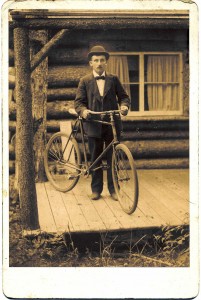I could ride anything, really. I’m sympathetic to a classic-looking design, just because I think the safety bicycle has proved itself as one of the all-time winning designs and a precursor to all kinds of other design innovations, from Marcel Breuer’s chair to the Centre Pompidou. If the insides are on the outside, in some way it resembles a bicycle.
So I admit to being a little bemused by the constant susurrus over the question of what kind of bicycle to ride, or the source of a bicycle and its components, the caliber of questions that arise when bicycles are treated like any other consumer product, say, for instance, coffee beans. Check the comments for one example. Sure, there are plenty of ethical issues that bicycle acquisition lies tangent to, just as with any consumer product. I wouldn’t buy one, cheap, from some skeevy-looking street person. I wouldn’t buy one welded together by eight-year-old girls in China. But beyond those cautions lies a deeper stratum of decision-making, apparently, that ranges from slow, heavy, comfort bikes with fenders, chain covers, and dress guards, epitomized by the Dutch “granny” bike, to sleeker, lighter, more “aggressive” (read hunched-over) single-speeds and racing bikes. If the bike is too heavy, it’s inconvenient for hill-climbing and longer distances; if it’s too fast, it makes the rider too sweaty to function in other activities of daily living. Advocates of the comfort bike posit that Americans don’t ride because they can’t find those bikes in stores; advocates of the single-speed affirm that Americans don’t ride because the bikes they can find are boat anchors that are too slow to enjoy riding.
I can rattle off to you my own recipe: mixte-frame, hard saddle, short cockpit, straight bar, three rings on the front gearset, wide, slick tires, fenders, a luggage rack, two locks and clipless pedals. That denotes the “helicopter,” my beloved commuting bike, which has gone through four different frames and at least three separate drivetrains. The “fixed-wing,” named in opposition to the helicopter, is the single-speed I rode in the secret city, viz. men’s frame, hard saddle, drop bar, single-speed, no derailleur, freewheel, racing tires, toe clips, and pedal straps. After a week of riding the helicopter, coasting the fixed-wing down the hill by my house on a Saturday morning feels like being shot out of a cannon. The helicopter, though, can hold more baggage, and its wider tires and lower center of gravity simulate driving a tank, if you could envision an oatmeal-fueled Abrams.
As you’ve just noticed, dear reader, an experiential approach to describing a bicycle is far more rich and absorbing than a prescriptivist one. I find the prescriptivist arguments a little stifling and airless. Whatever bike you ride, the experience of riding it is completely and uniquely yours. What I’m sharing with you this week, however, is that the quality of the parts can make a big difference in the quality of that experience. I just invested in a new set of wheels for the helicopter, and tires to match, which all told should cost about $200, or far more than I spent on the current frame. This morning I rode down to the job site and it was approaching transcendence until I met the stop light ten blocks away from my destination. The new wheelsets have made the ride smoother and tighter. It still feels like a tank, but a tank that can ride the center of a mechanical-pencil-narrow line. The braking is firmer because the rims are new, and the fenders don’t scrape the out-of-true wheels as they used to do. It makes quite a difference.
So, you can buy a bike at many different price points ($10 at a yard sale, $50 on an internet board, $150 at a department store, $250 at a bike shop) and get out riding, but eventually your pleasure in the experience will be compromised by the deterioration of your equipment. Replacing with better quality parts may appear quixotic, more expensive than replacing the whole bike, but two hundred bucks spent on wheelsets bolted to your original frame will boost the quality of your ride more than you might imagine.

